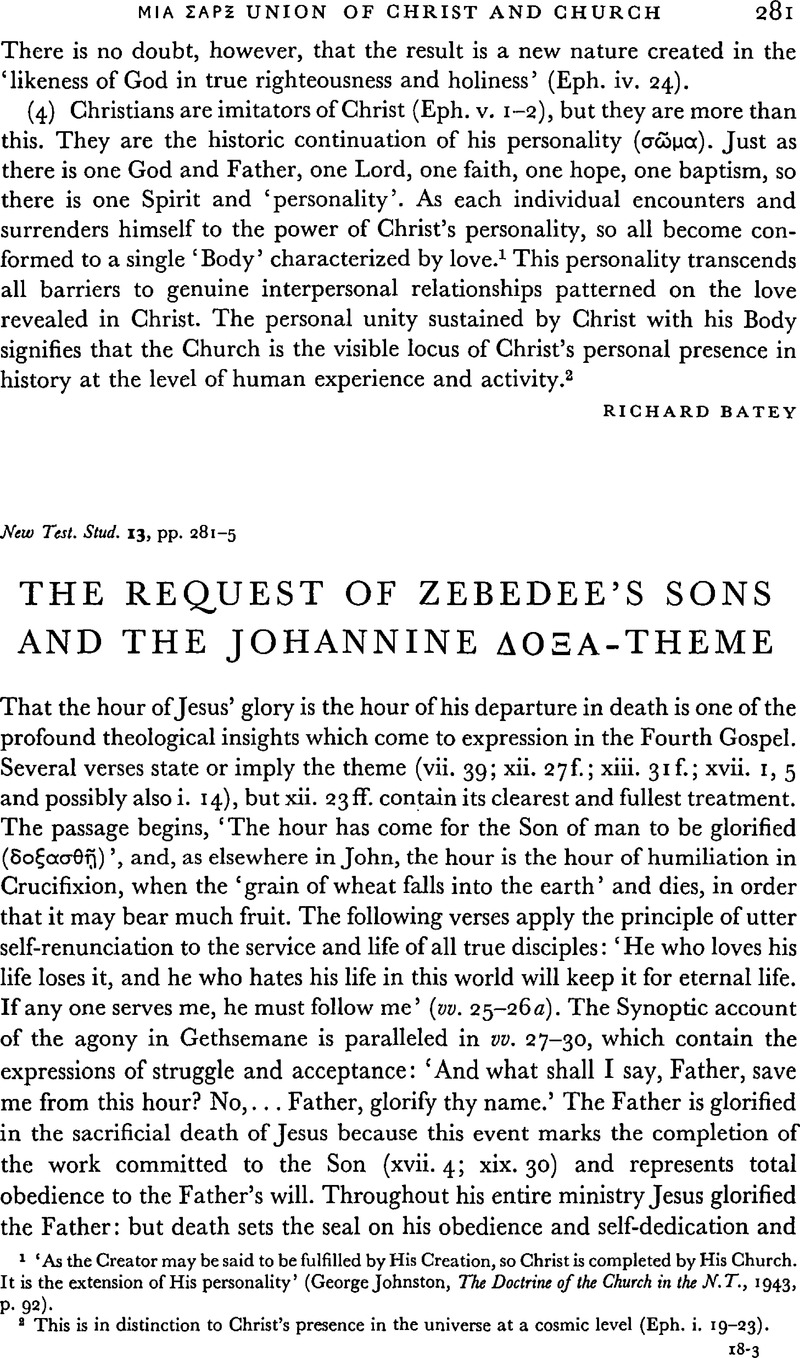No CrossRef data available.
Article contents
The Request of Zebedee's sons and the Johannine δόξα-Theme
Published online by Cambridge University Press: 05 February 2009
Abstract

Information
- Type
- Short Studies
- Information
- Copyright
- Copyright © Cambridge University Press 1967
References
page 281 note 1 ‘As the Creator may be said to be fulfilled by His Creation, so Christ is completed by His Church. It is the extension of His personality’ ( George, Johnston, The Doctrine of the Church in the N.T., 1943, p. 92).Google Scholar
page 281 note 2 This is in distinction to Christ's presence in the universe at a cosmic level (Eph. i. 19–23).
page 282 note 1 Cf. Dodd, C. H., Interpretation of the Fourth Gospel (Cambridge, 1953), p. 375Google Scholar, who also draws attention to LXX Ps. xxxvi. 20 and cxi. 9; Barrett, C. K., The Gospel according to St John (London, 1955), p. 179Google Scholar; and Black, M., ‘The Son of Man Problem in Recent Research and Debate’, B.J.R.L. XLV (1962–1963), 316.Google Scholar The language of Acts iii. 13, ‘The God of our fathers gloried his servant (παīς) Jesus, whom you delivered up and denied…’, is indebted to the Isaiah passage, but the verse does not express the paradox of glory in death which lies at the heart of John's theme.
page 282 note 2 Cf. Manson, T. W., On Paul and John (S.C.M., London, 1963), p. III.Google Scholar
page 282 note 3 Cf. Black, M., Aramaic Approach to the Gospels and Acts (Oxford, 2nd ed. 1954), pp. 127–8.Google Scholar
page 283 note 1 Cf. Dodd, C. H., Historical Tradition and the Fourth Gospel (Cambridge, 1963), pp. 358–9.CrossRefGoogle Scholar The idea of ‘becoming like children’ would lend itself to interpretation in terms of ‘rebirth’, especially in a Hellenistic milieu.
page 283 note 2 Cf. Manson, T. W., ‘The Son of Man in Daniel, Enoch and the Gospels’, B.J.R.L. XXXII (1949–1950), p. 191 n. I.Google Scholar The article is reprinted in Studies in the Gospels and Epistles (Manchester, 1962), pp. 121–45.Google Scholar
page 283 note 3 Cf. Lohmeyer, E., Lord of the Temple (Edinburgh, 1961), pp. 67, 69.Google Scholar
page 283 note 4 We might also consider the possibility that the miracle of the wine (John ii. 1–11) has developed from an original parable based on the wedding-feast theme (Matt. xxii. 1–14; XXV. 1–14 and Luke xii. 35–6), and on the saying of Mark ii. 22 concerning wine and wine-skins, which makes the same point as John does about the supersession of the old by the new.
page 284 note 1 Rawlinson, , St Mark (Westminster Comm. 7th ed., London, 1949), p. 144.Google Scholar
page 284 note 2 Jeremias, J., The Parables of Jesus (London, 1954), pp. 122 and 151–2 (new ed., 1963, pp. 218, 220).Google Scholar
page 284 note 3 Matt. xx. 21 has ‘in your kingdom’, but this does not necessarily mean the kingdom of God. In Matthew, Christ's kingdom is distinguished from the kingdom of the Father (cf. Matt. xiii. 41–3 and xxv. 31ff.). See Dodd, C. H., ‘Matthew and Paul’, E.T. LVIII (1947), 296ff.Google Scholar (reprinted in New Testament Studies (Manchester, 1953Google Scholar)).
page 284 note 4 The extremely dubious evidence for John's early martyrdom is not a sufficient ground for regarding this saying as a vaticinium ex eventu: in fact, aswe shall see, martyrdom is probably not envisaged or prophesied.
page 284 note 5 Cf. Ps. lxxv. 9; Isa. li. 17–22; Jer. xxv. 15ff.; xlix. 12; Ezek. xxiii. 31ff.; also IQpH xi. 10–15 and Ps. Sol. viii. 14. (But at LXX Ps. xvi. 5 ‘cup’ denotes ‘lot, portion’.) See the discussion by Delling, G., ‘βάπτıσμα Βαπτıσθ⋯ναı’, N.T. II (1957–1958), 92–115Google Scholar, esp. 92–5 on ‘cup’; and Best, E., The Temptation and the Passion (Cambridge, 1965), p. 153.Google Scholar
page 284 note 6 Best, op. cit. p. 155.
page 284 note 7 The imagery of baptism was not used to indicate martyrdom until the time of Irenaeus: see Bernard, J. H. on this verse in J.T.S. XXVIII (1927), 262–70.Google ScholarCullmann, O. (Baptism in the New Testament, London, 1950, pp. 19ff.)Google Scholar interprets the metaphor as referring to Jesus' baptism in death on behalf of all men, and sees it as the origin of the Pauline conception of baptism into the death of Christ (Rom. vi. 3). But Delling, loc. cit., argues that ‘baptism’ attained this fixed theological sense only after Jesus' death. Consequently, Cullmann's view may represent Mark's own understanding and theology.
page 284 note 1 H. van der Loos shows himself hostile to a symbolic interpretation of the fourth gospel in his recent work The Miracles of Jesus (Leiden, 1965), pp. 588–9, 609–18.Google ScholarPubMed
page 284 note 2 So, for example, de la Croix, P.-M.: ‘Le symbolisme apparaît déjà au plan le plus matériel: celui des nombres’ (L'Évangile de jean, Paris, 1959, p. 44).Google Scholar
page 284 note 3 R. H. Lightfoot holds it ‘likely’ that in this gospel ‘the notes of time sometimes carry a significance beyond their surface meaning’ ( St John's Gospel, Oxford, 1960, p. 103Google Scholar).
page 284 note 4 Bernard, Lagrange, Barrett, Lightfoot, Bultmann, Wikenhauser, to name but a few.
page 284 note 5 Westcott, Belser, and Kraft believed that the evangelist had adopted the official method.
page 284 note 6 Though he assumes that John is following Palestinian custom, Barrett states that ‘it is impossible to settle with complete certainty the method of enumerating the hours employed’ by John, (The Gospel According to St John, London, 1960, p. 194).Google Scholar The view that John is using the official method, not the Palestinian, has recently been revived by Walker, N.: ‘The Reckoning of Hours in the Fourth Gospel’, N.T. IV (1960), 69–73.Google Scholar

